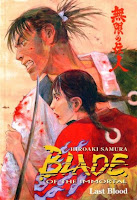 Creator: Hiroaki Samura
Creator: Hiroaki Samura
U.S. publisher: Dark Horse
ISBN: 9781593077822
Released: June 2007
Original release: 2004
Awards: Eisner Award, Japan Media Arts Award
On the Perfection of Anatomy is the seventeenth volume of Hiroaki Samura’s manga series Blade of the Immortal as published in English. Although the Japanese and English volumes collect slightly differently chapters, On the Perfection of Anatomy is most closely equivalent to the sixteenth volume of the Japanese release of the series, published in 2004. (The Japanese volume includes one additional chapter.) On the Perfection of Anatomy was released by Dark Horse in 2007. Blade of the Immortal has won several awards and honors, including a Japan Media Arts Award in 1998 and an Eisner Award in 2000. The series is also one my personal favorites. There were some fairly dramatic developments in the previous volume, Shortcut, so I was particularly interested in seeing where Samura would take things in On the Perfection of Anatomy.
Manji’s life has gotten more complicated ever since he became a near immortal. Even more so now that he has been captured and imprisoned in a hidden underground cell where he is the primary subject of an investigation into immortality. Manji and other felons are being experimented upon in an effort to transfer Manji’s bizarre regenerative powers to another person. Initially, the shogunate’s doctor Mozen was in charge of the investigation, but he was removed from the case after he was unable to produce results. Now the responsibility of finding the secrets behind Manji’s immortality has fallen to Ayame Burando, a young doctor who, due to his pursuit of Western medicine, is also considered a criminal. Burando sees the investigation not only as a way to redeem himself, but as an opportunity to advance the state of Japanese medicine.
Most of On the Perfection of Anatomy is devoted to Burando and the experiments he is conducting in the prison. Burando was first introduced in the previous volume, Shortcut. He goes through some very significant changes as a person by the end of On the Perfection of Anatomy. Burando was originally so devoted to advancing his own knowledge of medicine that he was willing to risk his own life. He tried to leave Japan in order to study Western medicine, inviting execution should he be caught or try to return. Ultimately he was found out which is how he became involved with the immortality experiments. At first things go astonishing well, but then Burando is confronted by failure after failure. Faced with this, his struggle as he tries to justify himself as both a scientist and doctor changes him.
Some of the experiments carried out in Shortcut and On the Perfection of Anatomy and their results are truly horrifying. Samura’s artwork captures the grotesqueness, terror, and despair as bodies fall apart and waste away. The experiments are not only physically damaging, they also take a huge mental toll on most of the people who are even remotely involved with them. Of course, there are also those who don’t appear to be affected much at all, which is a little terrifying in its own right. On the Perfection of Anatomy doesn’t actually advance the plot of Blade of the Immortal much, but it is a critical volume in the characters’ development, particularly Burando’s evolution. And, as usual, I’m very interested in reading the next volume in the series, The Sparrow Net.




